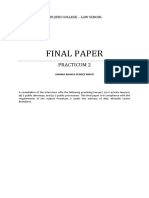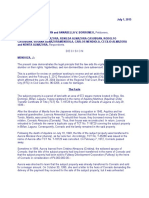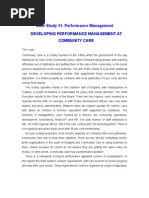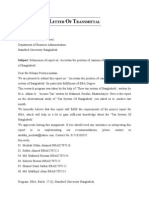0 ratings0% found this document useful (0 votes)
119 viewsOn Adultery
On Adultery
Uploaded by
AikeeBeltran- In criminal cases, the prosecution must prove every element of the crime beyond a reasonable doubt. Proof beyond a reasonable doubt means proof sufficient to overcome the presumption of innocence and preclude every reasonable hypothesis except guilt.
- Circumstantial evidence can constitute proof beyond a reasonable doubt if there is a series of circumstances consistently proved that are consistent with guilt and inconsistent with innocence.
- Adultery is a crime committed with each sexual intercourse. It can be difficult to prove with direct evidence so circumstantial evidence and corroborating evidence leading to the conclusion the act was committed can be sufficient for conviction.
Copyright:
© All Rights Reserved
Available Formats
Download as DOCX, PDF, TXT or read online from Scribd
On Adultery
On Adultery
Uploaded by
AikeeBeltran0 ratings0% found this document useful (0 votes)
119 views4 pages- In criminal cases, the prosecution must prove every element of the crime beyond a reasonable doubt. Proof beyond a reasonable doubt means proof sufficient to overcome the presumption of innocence and preclude every reasonable hypothesis except guilt.
- Circumstantial evidence can constitute proof beyond a reasonable doubt if there is a series of circumstances consistently proved that are consistent with guilt and inconsistent with innocence.
- Adultery is a crime committed with each sexual intercourse. It can be difficult to prove with direct evidence so circumstantial evidence and corroborating evidence leading to the conclusion the act was committed can be sufficient for conviction.
Original Title
On Adultery.docx
Copyright
© © All Rights Reserved
Available Formats
DOCX, PDF, TXT or read online from Scribd
Share this document
Did you find this document useful?
Is this content inappropriate?
- In criminal cases, the prosecution must prove every element of the crime beyond a reasonable doubt. Proof beyond a reasonable doubt means proof sufficient to overcome the presumption of innocence and preclude every reasonable hypothesis except guilt.
- Circumstantial evidence can constitute proof beyond a reasonable doubt if there is a series of circumstances consistently proved that are consistent with guilt and inconsistent with innocence.
- Adultery is a crime committed with each sexual intercourse. It can be difficult to prove with direct evidence so circumstantial evidence and corroborating evidence leading to the conclusion the act was committed can be sufficient for conviction.
Copyright:
© All Rights Reserved
Available Formats
Download as DOCX, PDF, TXT or read online from Scribd
Download as docx, pdf, or txt
0 ratings0% found this document useful (0 votes)
119 views4 pagesOn Adultery
On Adultery
Uploaded by
AikeeBeltran- In criminal cases, the prosecution must prove every element of the crime beyond a reasonable doubt. Proof beyond a reasonable doubt means proof sufficient to overcome the presumption of innocence and preclude every reasonable hypothesis except guilt.
- Circumstantial evidence can constitute proof beyond a reasonable doubt if there is a series of circumstances consistently proved that are consistent with guilt and inconsistent with innocence.
- Adultery is a crime committed with each sexual intercourse. It can be difficult to prove with direct evidence so circumstantial evidence and corroborating evidence leading to the conclusion the act was committed can be sufficient for conviction.
Copyright:
© All Rights Reserved
Available Formats
Download as DOCX, PDF, TXT or read online from Scribd
Download as docx, pdf, or txt
You are on page 1of 4
—In criminal cases, the prosecution must prove beyond a
reasonable doubt every essential element constituting the
crime, upon which the conviction and punishment must be
based. U.S. vs. Capa and Cariño, 19 Phil. 125.
Proof beyond a reasonable doubt is such proof as is
sufficient to overcome the presumption of innocence and to
preclude every reasonable hypothesis except that which it
is given to support. It has been said that a reasonable
doubt is the doubt of a reasonable man under all
circumstances of the case. The statement is too general and
includes too much. Neither does the rule that the judge
must be convinced beyond a reasonable doubt mean that he
must be convinced to an absolute certainty. This
construction would preclude a conviction upon
circumstantial evidence. U.S. vs. Reyes, 3 Phil. 3.
By reasonable doubt of guilt is not meant that which of
possibility may arise, but it is that doubt engendered by an
investigation of the whole proof and an inability, after such
investigation, to let the mind rest easy upon the certainty
of guilt. Absolute certainty of guilt is not demanded by the
law to convict of a criminal charge, but moral certainty is
required as to every proposition of proof requisite to
constitute the offense. U.S. vs. Lasada, 18 Phil. 90.
If the inculpatory facts and circumstances in a criminal
case are capable of two or more explanations, one
consistent with innocence and the other with guilt, the
evidence does not fulfill the test of moral certainty and is
not sufficient to support a conviction. People vs. Abana, 76
Phil. 1; People vs. Agpangan, 79 Phil. 334; People vs.
Bautista, 81 Phil. 78; and People vs. Abendan, 82 Phil. 711.
It is the theory of circumstantial evidence that indicia
that are separately of little importance may, by their
concordant combination and cumulative effect, satisfy the
legal requirements for proof beyond a reasonable doubt.
People vs. Viernes, L-9326, June 18, 1956. In order that
circumstantial evidence may constitute proof beyond a
reasonable doubt, there must be a series of circumstances
satisfactorily proved and consistent with each other, of
such nature that every one of them is consistent with
defendant’s guilt and inconsistent with his innocence.
People vs. Mahlon, L-5198, April 17, 1953.
To put it another way, there must be more than one circumstance
and all the circumstances must be consistent with each
other, consistent with the hypothesis that the accused is
guilty, and at the same time inconsistent with the
hypothesis that he is innocent. People vs. Labita, L-8481,
September 15, 1956.
Adultery is not continuing offense; Abuse of unity or
criminal intent or purpose.—The notion or concept of a
continuous crime has its origin in the juridical fiction
favorable to the law transgressors and in many a case
against the interest of society (Cuello Calon, Derecho
Penal, Vol. II. p, 521). For it to exist there should be
plurality of acts performed separately during a period of
time; unity of penal provision infringed upon or violated;
and unity of criminal intent or purpose, which means that
two or more violations of the same penal provision are
united in one and the same intent leading to the
perpetration of the same criminal purpose or aim (Ibid., p.
520). ln adultery, the last unity does not exist because the
culprits perpetrate the crime in every sexual intercourse
and they need not do another or other adulterous acts to
consummate it. People vs. Zapata and Bondoc, 88 Phil. 688.
Conviction for one act does not bar prosecution for other
adulterous acts.
Each sexual intercourse a crime.—Adultery is a crime of
result and not of tendency, as the Supreme Court has held
(S. 10 December 1945); it is an instantaneous crime which
is consummated and exhausted or completed at the
moment of the carnal union. (Cuello Calon, Derecho Penal,
Vol. II, p. 569). Ibid.
Adultery is often proved by circumstantial evidence.
—The nature of the crime of adultery is such that it will
not be often when it can be established by direct evidence.
Nevertheless, strong circumstantial and corroborative
evidence such as will lead the guarded discretion of a
reasonable and just man to the conclusion that the alleged
act has been committed is sufficient to sustain a conviction
for adultery. (Groizard, Codigo Penal, p. 24, et seq.;
Decision of the Supreme Court of Spain of June 23, 1874; 1
R.C.L., par. 28) In the case of U.S. vs. Feliciano, 36 Phil.
753, a photograph was introduced in evidence showing
the intimate relations of the two accused. Another witness
testified to having seen them in scant apparel and sleeping
together. The woman and her paramour had 'the
opportunity to satisfy their adulterous inclination. A
finding to the effect that they had carnal relations is
sufficiently in accord with the probabilities of the case and
the proof.
In U.S. vs. Legaspi, 14 Phil. 38, it was held that the finding in
the possession of a married woman of several love
letters signed by her paramour; their having been together
in different places and the fact that they were surprised in
a well known assignation house which the accused woman
admitted to have visited six times in company with her
paramour are data and indications sufficient to convict
them both of adultery.
In another case, People vs. Osorio, CA-G.R. No. 19475-K,
June 12, 1958, the offended husband took a search warrant
and he searched the house where his wife and her
paramour were staying and found them partially disrobed
in one bed, the bed showing signs of having been used,
while their clothes were mixed together, these
circumstances indicate adultery (U.S. vs. Legaspi, supra).
Direct proof of carnal knowledge not necessary.—Direct
proof of carnal knowledge is not necessary to sustain a
conviction for adultery. In the very nature of things, it is
seldom that adultery can be established by direct
evidence. The legal tenet, therefore, has been and still is
that circumstantial and corroborative evidence such as
will lead the guarded discretion of a reasonable and just
man to ,'the conclusion that the criminal act of adultery
has been committed, will suffice to bring about a conviction
f or that crime. Where defendants, lived together as
husband and wife in different places, at diverse times and
for certain periods and actually were seen lying together at
late' hours to the night in their underwear and caressing
and embracing each other, these facts more than sufficiently
prove the crime of adultery. (U.S; vs. Legaspi, 14
Phil. 38; U.S. vs. Feliciano, 36 Phil. 753; People vs.
Fernando, CA-G.R. No. L-7148-R, promulgated February
15, 1952.) People vs. Dantes, Off. Gaz., Vol. 51, No. 2, Feb.
1955, p. 801.
Circumstantial evidence; Factual situation and
circumstances, not absolutely incompatible with innocence
of accused.—True that the proof of the illicit intercourse
may safely be rested on circumstantial evidence, but the
factual situation in a case and the circumstances relied
upon by the prosecution are not absolutely incompatible
with the innocence of the accused and not incapable of
explanation other than of their guilt. The fact that the
accused met each other once in a while is explained by the
existing relation between them, that is, accused man has
been the repairer of the defective sewing machines of the
spouses and their agent on com-
mission in the sale of machines he could repair because
since 1946, accused woman, with the consent of her
husband, has been engaged in buying defective sewing
machines and selling them after their repair at a gain.
People -vs. Malasig and Retotal, CA-G.R. No. 4666-R, April
29, 1950
You might also like
- Topic Sentence and Supporting DetailsDocument3 pagesTopic Sentence and Supporting DetailsAlfeo OriginalNo ratings yet
- Be It Enacted by The Senate and House of Representatives of The Philippines in Congress AssembledDocument5 pagesBe It Enacted by The Senate and House of Representatives of The Philippines in Congress AssembledPingotMaganga100% (1)
- CBF 22.4A - Party's Terms of ReferenceDocument6 pagesCBF 22.4A - Party's Terms of ReferenceGeneve MasahudNo ratings yet
- PRE-TRIAL BRIEF - Macapagal Vs TRI (Figueroa & Levanza)Document6 pagesPRE-TRIAL BRIEF - Macapagal Vs TRI (Figueroa & Levanza)Jeremy Ryan Chua0% (1)
- Table of Specifications - Law On Obligations and ContractsDocument1 pageTable of Specifications - Law On Obligations and ContractsThea FloresNo ratings yet
- War crimes and crimes against humanity in the Rome Statute of the International Criminal CourtFrom EverandWar crimes and crimes against humanity in the Rome Statute of the International Criminal CourtNo ratings yet
- Ragnarok M - Cooking Recipe Book PDFDocument20 pagesRagnarok M - Cooking Recipe Book PDFAikeeBeltranNo ratings yet
- Sample Judicial AffidavitDocument3 pagesSample Judicial AffidavitRoland Bon IntudNo ratings yet
- Trial Memorandum Prac CourtDocument4 pagesTrial Memorandum Prac CourtLawrence Louie UyNo ratings yet
- POSITION PAPER - Cayton vs. TorresDocument7 pagesPOSITION PAPER - Cayton vs. TorresNonnatus P ChuaNo ratings yet
- Complaint Quasi DelictDocument5 pagesComplaint Quasi DelictJohn SanchezNo ratings yet
- RA 10354 Petition SC James ImbongDocument25 pagesRA 10354 Petition SC James ImbongCBCP for LifeNo ratings yet
- Republic of The Philippines National Capital Judicial Region Regional Trial Court Branch 12, Olongapo CityDocument23 pagesRepublic of The Philippines National Capital Judicial Region Regional Trial Court Branch 12, Olongapo CityJustine DagdagNo ratings yet
- People Vs Zapata Cross-Examination LuckyDocument3 pagesPeople Vs Zapata Cross-Examination LuckyJohnNicoRamosLuceroNo ratings yet
- Court Testimony (BFP Specialized Presentation)Document19 pagesCourt Testimony (BFP Specialized Presentation)Doni June AlmioNo ratings yet
- NCMH CTZ Charter 2023 5Document187 pagesNCMH CTZ Charter 2023 5Arianne Khei MarasiganNo ratings yet
- Memorandum Annulment - Google SearchDocument2 pagesMemorandum Annulment - Google SearchSarah Jane-Shae O. SemblanteNo ratings yet
- I - Crim - SB-18-CRM-0385-0387 - People Vs Cortez, Et Al - 09 - 04 - 2019 PDFDocument4 pagesI - Crim - SB-18-CRM-0385-0387 - People Vs Cortez, Et Al - 09 - 04 - 2019 PDFKin Pearly FloresNo ratings yet
- Sales Mid TermDocument1 pageSales Mid TermJohn PaulNo ratings yet
- Bebe KhoDocument3 pagesBebe KhoMetoi AlcruzeNo ratings yet
- What Is The Scope and Applicabilty of The Rule?Document5 pagesWhat Is The Scope and Applicabilty of The Rule?Solomon Malinias BugatanNo ratings yet
- FINAL PAPER Practicum 2 - BIRAODocument31 pagesFINAL PAPER Practicum 2 - BIRAOAianna Bianca Birao (fluffyeol)No ratings yet
- Petition For Notarial Commission2Document3 pagesPetition For Notarial Commission2Race Del RosarioNo ratings yet
- Teehankee Moot CompromisDocument13 pagesTeehankee Moot CompromisYeyen M. EvoraNo ratings yet
- Complaint AffidavitDocument2 pagesComplaint Affidaviteryhll panganibanNo ratings yet
- TSN Edited Prosec WitnessDocument17 pagesTSN Edited Prosec Witnessraymond gwapoNo ratings yet
- LLM Thesis UPDocument112 pagesLLM Thesis UPMaria Emma Gille MercadoNo ratings yet
- REAL ESTATE MORTGAGE CabatoDocument3 pagesREAL ESTATE MORTGAGE CabatoHash IbrahimNo ratings yet
- Hearsay: People V. Cusi Jr. Facts: IssuesDocument5 pagesHearsay: People V. Cusi Jr. Facts: Issuescmv mendozaNo ratings yet
- Primer For Libel and Cyber Libel PDFDocument11 pagesPrimer For Libel and Cyber Libel PDFNava NavarreteNo ratings yet
- Criminal-Law-Review-Practice QuestionDocument41 pagesCriminal-Law-Review-Practice QuestionJana Marie CorpuzNo ratings yet
- Pleadings - SummaryDocument10 pagesPleadings - SummaryJotham FunclaraNo ratings yet
- CHAPTER 11 CIVIL LIABILITY ARISING FROM DELICT - GutierrezMerlynDocument31 pagesCHAPTER 11 CIVIL LIABILITY ARISING FROM DELICT - GutierrezMerlynLenNo ratings yet
- Affidavit of Consent-TemplateDocument1 pageAffidavit of Consent-TemplateRamil ImperialNo ratings yet
- San Sebastian College - Recoletos de Manila: Module 1: Introduction To Human Rights LawDocument10 pagesSan Sebastian College - Recoletos de Manila: Module 1: Introduction To Human Rights LawPrincess Aileen EsplanaNo ratings yet
- Criminal Law II - Quasi OffensesDocument2 pagesCriminal Law II - Quasi OffensesJanine Prelle Dacanay100% (1)
- Criminal Law Book 1Document49 pagesCriminal Law Book 1Elmar DaniNo ratings yet
- Elements of TRODocument2 pagesElements of TROKC SoNo ratings yet
- Application For ProbationDocument2 pagesApplication For ProbationMeng GoblasNo ratings yet
- Remr FINAL EXAMINATION 2016Document6 pagesRemr FINAL EXAMINATION 2016Pilacan KarylNo ratings yet
- 05 Memorandum - FinalDocument6 pages05 Memorandum - FinalJenny Lyn MahinayNo ratings yet
- AFFIDAVIT Vs SwornDocument2 pagesAFFIDAVIT Vs Swornlhindy5577No ratings yet
- Nego Forgery CasesDocument93 pagesNego Forgery CasesKristine ComaNo ratings yet
- Position Paper Eusebio GumagaDocument3 pagesPosition Paper Eusebio GumagaAlfredSeldaCasipongNo ratings yet
- Chairperson 2009 Bar Examinations Committee: Criminal LawDocument4 pagesChairperson 2009 Bar Examinations Committee: Criminal LawMaria Cristina MartinezNo ratings yet
- Legal Research Syllabus-1Document3 pagesLegal Research Syllabus-1Pauline Eunice Sabareza LobiganNo ratings yet
- 195 PEOPLE v. RECTODocument4 pages195 PEOPLE v. RECTOav783No ratings yet
- 15A.1Recognition of Foreign Divorce Decree by Philippine CourtsDocument3 pages15A.1Recognition of Foreign Divorce Decree by Philippine Courtscertiorari19No ratings yet
- Republic of The Philippines Regional Trial Court Practice Court Ii City of ManilaDocument7 pagesRepublic of The Philippines Regional Trial Court Practice Court Ii City of ManilaAriel Joseph NicolasNo ratings yet
- Position Paper Josefino JimenezDocument44 pagesPosition Paper Josefino JimenezHaroldRamosNo ratings yet
- 161264306-Court of Appeals Sample-Decision PDFDocument30 pages161264306-Court of Appeals Sample-Decision PDFrobertoii_suarezNo ratings yet
- Laches and Prescription JurisprudenceDocument10 pagesLaches and Prescription JurisprudenceNina Anne ParacadNo ratings yet
- Research On Internet Libel and Available JurisprudenceDocument3 pagesResearch On Internet Libel and Available JurisprudenceEla A100% (1)
- Discharge As State WitnessDocument2 pagesDischarge As State WitnessNoelle Therese Gotidoc VedadNo ratings yet
- Remedial Law MCQDocument2 pagesRemedial Law MCQJon Frederick DiñoNo ratings yet
- AlibiDocument2 pagesAlibiFrancesco Celestial BritanicoNo ratings yet
- Jurisprudence 2Document4 pagesJurisprudence 2KarlaAlexisAfableNo ratings yet
- Walking a Tightrope: Biography of Honorable Mayor Catalino Gabot Hermosilla Sr.From EverandWalking a Tightrope: Biography of Honorable Mayor Catalino Gabot Hermosilla Sr.No ratings yet
- 21 People v. Ritter 194 SCRA 690 March 5 1991Document34 pages21 People v. Ritter 194 SCRA 690 March 5 1991BJMP NCR PATEROS CITY JAILNo ratings yet
- Art 3-6BDocument146 pagesArt 3-6BCJNo ratings yet
- Espineli vs. People, 725 SCRA 365Document18 pagesEspineli vs. People, 725 SCRA 365Athena Jeunnesse Mae Martinez TriaNo ratings yet
- 330 People V Padua (2007)Document20 pages330 People V Padua (2007)Neil BorjaNo ratings yet
- in Re Petition For Change of Name of Julian WangDocument1 pagein Re Petition For Change of Name of Julian WangAikeeBeltranNo ratings yet
- CIV 2 - Krisha CDs - CREDIT TRANSACTIONS PDFDocument113 pagesCIV 2 - Krisha CDs - CREDIT TRANSACTIONS PDFAikeeBeltranNo ratings yet
- Republic v. Sagun PDFDocument14 pagesRepublic v. Sagun PDFAikeeBeltranNo ratings yet
- David v. Poe-Llamanzares PDFDocument114 pagesDavid v. Poe-Llamanzares PDFAikeeBeltranNo ratings yet
- Transpo Full Text Cases Batch1Document395 pagesTranspo Full Text Cases Batch1AikeeBeltranNo ratings yet
- Viray Vs PeopleDocument15 pagesViray Vs PeopleAikeeBeltranNo ratings yet
- Interview RequestDocument1 pageInterview RequestAikeeBeltranNo ratings yet
- July 13, 2019: 1-E Constitutional Law Ii - Atty. Gabriel 1-E Obligations and Contracts - Atty. TaleonDocument1 pageJuly 13, 2019: 1-E Constitutional Law Ii - Atty. Gabriel 1-E Obligations and Contracts - Atty. TaleonAikeeBeltranNo ratings yet
- Múgiithi Music As Social Discourse in Urban KenyaDocument17 pagesMúgiithi Music As Social Discourse in Urban KenyakiopogmailcomNo ratings yet
- Art Description: The Subject Matter AnswersDocument5 pagesArt Description: The Subject Matter AnswersABDULLAH RENDONNo ratings yet
- India With Thanks To WikipediaDocument28 pagesIndia With Thanks To WikipediaAnjum Ziauddin TajiNo ratings yet
- Transformative Learning Teacherr ResourceDocument6 pagesTransformative Learning Teacherr Resourceapi-491313026No ratings yet
- Communication Skills: March 2017Document25 pagesCommunication Skills: March 2017tintuNo ratings yet
- Ccu 1Document4 pagesCcu 1amelia goldaNo ratings yet
- NCF Secondary Education-2000 PDFDocument77 pagesNCF Secondary Education-2000 PDFsavleen kaurNo ratings yet
- Agile Task Order ExampleDocument30 pagesAgile Task Order Exampleرهف عبد اللهNo ratings yet
- School Ed 211Document1 pageSchool Ed 211Francis Joseph V BatuigasNo ratings yet
- Bureaucratic and Charismatic LeadershipDocument27 pagesBureaucratic and Charismatic LeadershipMac OngNo ratings yet
- Jojo Law Chapter.... 3Document7 pagesJojo Law Chapter.... 3Cynthia AumaNo ratings yet
- Pangasinan National High School 10 Christian M. Valle English 10 2 QuarterDocument5 pagesPangasinan National High School 10 Christian M. Valle English 10 2 QuarterChristian ValleNo ratings yet
- Tabel Contoh Hiit MetaanalisisDocument5 pagesTabel Contoh Hiit MetaanalisisninaindriyaninNo ratings yet
- 02 31 Teaching Notes Case Study - Performance ManagementDocument4 pages02 31 Teaching Notes Case Study - Performance ManagementAmna Mubarak67% (3)
- Janam Janam Janam Sath Chalna Yuhi Kasam Tumhe Kasam Ake Milna Yuhi Ek Jaaan Hain YahiDocument2 pagesJanam Janam Janam Sath Chalna Yuhi Kasam Tumhe Kasam Ake Milna Yuhi Ek Jaaan Hain YahiUdayveerSinghNo ratings yet
- Capstone Pitch TemplateDocument12 pagesCapstone Pitch Templatebenashishy_881649557No ratings yet
- Tax System of BangladeshDocument24 pagesTax System of BangladeshRonysars85% (13)
- Risk ManagementDocument2 pagesRisk ManagementRana GaballahNo ratings yet
- FAQ About Islam, Dialog With Non Muslims On Topix - Vol 5Document289 pagesFAQ About Islam, Dialog With Non Muslims On Topix - Vol 5Moiz Uddin QidwaiNo ratings yet
- FI Form of Information - 04 February 2020 - v1.3: Code Group Sub Group Section Object Title NBS Code NRMDocument2 pagesFI Form of Information - 04 February 2020 - v1.3: Code Group Sub Group Section Object Title NBS Code NRMabdullah sahibNo ratings yet
- Organization and Management Student Learning ModuleDocument7 pagesOrganization and Management Student Learning ModuleJoan Mae Angot - VillegasNo ratings yet
- Low Cost MarketingDocument20 pagesLow Cost MarketingCauvery C HydNo ratings yet
- Risk Management Chapter 1Document31 pagesRisk Management Chapter 1Mercado jomerNo ratings yet
- UBT Workout GuidelinesDocument3 pagesUBT Workout GuidelinesJosephine ConsalNo ratings yet
- 2nd Quiz ENG201 (Solved)Document5 pages2nd Quiz ENG201 (Solved)mbilalctnNo ratings yet
- Community EngagementDocument3 pagesCommunity EngagementNonito C. Arizaleta Jr.No ratings yet
- Management 105 SyllabusDocument3 pagesManagement 105 SyllabusMiche Fritz ArcheNo ratings yet
- Notice: Registration Revocations, Restrictions, Denials, Reinstatements: Bhasin, Sunil, M.D.Document2 pagesNotice: Registration Revocations, Restrictions, Denials, Reinstatements: Bhasin, Sunil, M.D.Justia.comNo ratings yet
- TQM LeadershipDocument14 pagesTQM LeadershipmalikdadbalochNo ratings yet


































































































